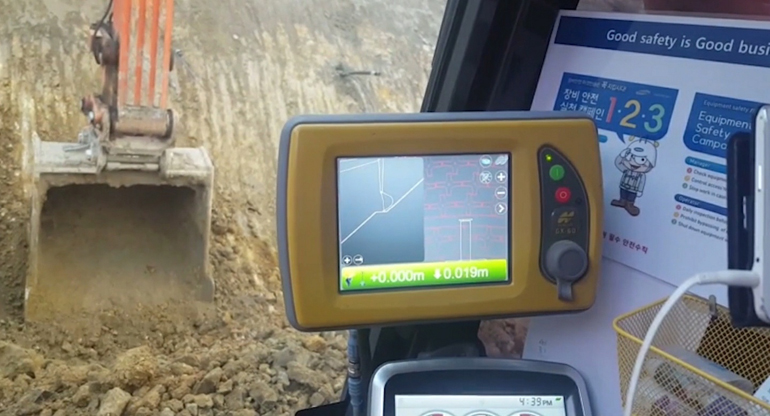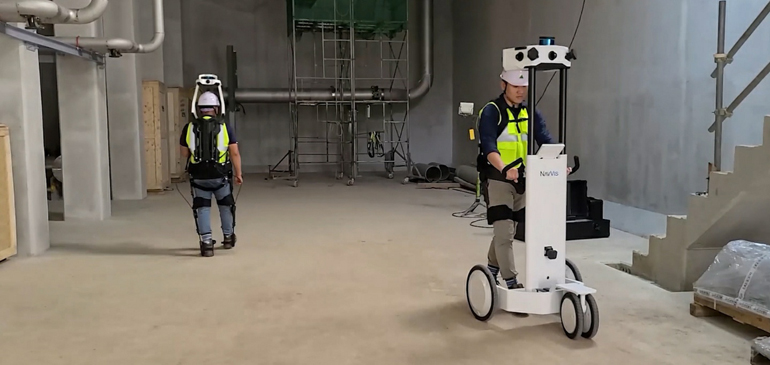
Latest News
- Hyundai E&C Signs PPA for Solar Renewables with Glennmont D&D Solar Holdings
- Hyundai E&C to Embark on UK SMR Project forging Korea-US-UK Technology Alliance
- Hyundai E&C Consolidates Leading Position in Concrete Safety and Quality Technology
- Hyundai E&C Selected as Preferred Bidder for Large Nuclear Power Plant in Bulgaria
- Hyundai E&C Attains “Leadership A” in CDP's Climate Change Assessment
Hyundai E&C hosts Smart Construction Technology Demonstration
Hyundai E&C hosts Smart Construction Technology Demonstration
Taking the lead in the Fourth Industrial Revolution through digital technology innovation
.jpg)
Cho Sung-min, head of the Center for Smart Construction Technology of the Korea Expressway Corporation (first from the right) and Kim Ki-bum, head of the Infrastructure Division of Hyundai E&C (second from the right) listen to explanations on laser scanners.
Hyundai E&C held the “Hyundai E&C Smart Construction Technology Demonstration” in a promotion hall at the project site of the Sejong-Pocheon Expressway Section 14: Godeok Bridge” located in Guri-si, Gyeonggi-do, on November 12, 2020.
The event started with lectures and demonstrations for related technologies, attended by academic and business experts and officials with regard to smart construction, such as Cho Sung-min, head of *the Center for Smart Construction Technology of the Korea Expressway Corporation, Kim Ki-bum, head of the Infrastructure Division of Hyundai E&C, and Shim Chang-su, head of the Korea Institute of Building Information Modeling and professor of Chung-Ang University. In his guest lecture, Cho Sung-min, head of the Center for Smart Construction Technology, put an emphasis on the introduction of smart construction technologies through digitalization as a way for the Korean industry to boost its competitiveness in the global stage. Along with the introduction of the development status of smart construction technologies, Hyundai E&C gave demonstrations and simulations of a total of 27 cutting-edge technologies such as its own HIoS, BIM and wearable robots.
* The Center for Smart Construction Technology is operated by the Korea Expressway Corporation and designated by the Ministry of Land, Infrastructure and Transport as an institution in charge of digital innovation of the construction industry. |
.jpg)
Demonstration of UGV equipment used for the inspection, measurement and management of construction sites
Venue to look back on the future technology innovation organization fostered by Hyundai E&C for the past decade and to demonstrate digital construction technologies in the infrastructure, building and housing construction areas
Hyundai E&C has promoted an organization for future technology innovation for the past decade and conducted research on a constant basis to phase in smart construction technologies in its business divisions.
During the demonstration event, Hyundai E&C introduced HIoS, its own safety management system using IoT (Internet of Things). It is all the more meaningful in that the IoT sensor-based safety management system, developed by the builder’s own technology, is applied to various construction sites ranging from tunnels and buildings to bridges. HIoS, a real-time, remote location control system designed to advance the existing safety management system as a result of the enlargement and complication of construction sites, can prevent safety accidents of workers in blind spots from taking place by responding to them in real time.

VR simulation of 3D design drawings
In the demonstration hall, Hyundai E&C presented *BIM (Building Information Modeling), a key smart construction technology; *CDE (Common Data Environment), a collaborative solution in which design information can be shared in an effective way; VR (Virtual Reality) and AR (Augmented Reality) enabling users to review construction plans of construction sites in a virtual environment; *UAV (Unmanned Aerial Vehicle) enabling manless site management; the high-precision GPS measurement system which contributes to precise construction of towers; the mobile curing management system of ultra-high strength concrete; and *AMG (Automated Machine Guidance) system for tower cranes.
* BIM (Building Information Modeling) refers to a system which supports users in integrating all information of structures based on three-dimensional designs. |

A MG and MC device which can improve accuracy of earth works
Outside the hall were demonstrated *LiDAR-equipped drones and *UGV (Unmanned Ground Vehicle). As digital inspection and measurement devices, the equipment is expected to improve efficiency of site management by streamlining inspection and measurement works at construction sites and increasing measurement accuracy.
Hyundai E&C recently introduced MG (Machine Guidance) and MC (Machine Control), half-automated control systems designed to provide workers with information on locations, depths and gradients of earth works in real time. These systems are actively in use at the construction site of the Hankook Tire Driving Experience Center project. Hyundai E&C will increase the use of these systems in all its construction sites.
Wearable robots are intended to increase physical strengths of workers by sensing their movements. This technology enables construction workers to more easily move loads with the consumption of less energy, which will help them transfer construction materials.
Hyundai E&C aims to put industrial robots into use at its projects sites by 2026. The builder attempted to apply “unmanned patrol robots” for site management and “construction robots” for the purpose of booting the efficiency of repeated works including welding and painting at some of its domestic construction sites.
* LiDAR (Light Detection and Ranging) can show precise images of surrounding areas by using laser pulses to measure the distances to objects. |

Workers in wearable robots designed to increase strength
Hyundai E&C aims to overcome issues of profitability, accident rate and aging workforce through the introduction of smart construction technologies
In a bid to overcome lingering issues in the construction industry such as low profitability, higher accident rate compared to other industries and the aging workforce, Hyundai E&C will promote digital innovation in the construction of bridges, tunnels, roads, buildings and apartments by transforming the conventional construction methods depending largely on the workforce into smart construction methods including digital devices and robots.

Demonstration of a quadruped walking robot
“Smart construction technologies in the fourth industrial era are an important key to solving the imminent tasks facing the construction industry. We hope this event can contribute to the development of the domestic construction industry by introducing and sharing our knowhow on future technology,” said an official of Hyundai E&C. “We will develop into a global top-tier company by making an investment in R&D and reinforcing a cooperative system on a constant basis.”

